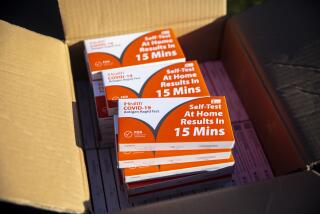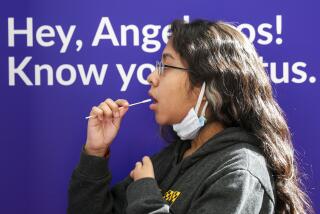Serious breakdown in California systems causes inaccurate coronavirus numbers

A breakdown in the electronic collection of coronavirus test data is hampering California’s pandemic response, with some public health officials resorting to counting results by hand and a growing number of counties warning the public that statistics provided by the state on infection rates are unreliable.
The ongoing technical problems with the electronic system for gathering and analyzing COVID-19 infection rates affect the state’s ability to track the spread of the virus and could be resulting in significant undercounts of infections across the state.
That was on vivid display Tuesday when the state’s top public health official acknowledged that Gov. Gavin Newsom had inadvertently provided flawed information on Monday that showed a steep decline — 21.2% — in the state’s seven-day average for infections.
State officials have said they don’t know how long and to what extent the problems have existed in the state’s CalREDIE electronic system, which collects information from laboratories and feeds it to state and local health departments. Officials have said it is unknown when the system will be running again, and did not provide additional details on Wednesday.
The accurate collection of test result data is crucial for public health officials in guiding their pandemic response and for projecting likely transmission rates and assisting contact tracing efforts. Inaccurate data could misshape the public’s perception of the state of the pandemic, say experts.
“The information you’re giving to the public over the last few days gives people the sense that we are doing better, and that they can relax. That might not be true,” said Dr. Bob Kocher, a former member of Newsom’s testing task force who worked as a White House healthcare official during the Obama administration.
“We reported to the public that they went from 10,000 to 5,000 a day. If you’re looking at the data, you think we’re doing better. You might be less vigilant; you might take more chances. You might think it’s less active in your area,” he said.
Data analysis of test results in recent days has deteriorated to the point that the state health department is implementing manual processes to retrieve the information. Several counties have added a note to their COVID-19 dashboards, warning that the numbers may not be true indicators of the coronavirus’ full impact. And in Los Angeles County, where officials on Wednesday reported 68 additional COVID-19-related deaths and 2,347 cases, health officials are working to contact at least 81 laboratories to obtain test results since July 26 in order to determine an accurate case count.
The snafus recall similar problems that plagued the response in the early weeks of the pandemic. Santa Clara County Public Health Officer Dr. Sara Cody said in a news conference Wednesday that the flawed data has officials “back to feeling blind.”
“We don’t know how the epidemic is trending,” she said. “This lack of data doesn’t let us know.”
The technical problems, say health officials, do not affect the reporting of hospitalization data, which is collected separately from the CalREDIE system. But California Department of Public Health officials said in late July that such information may still be undercounted due to how the Trump administration changed the way in which hospitals must report those numbers.
On Tuesday at least 201 deaths were reported statewide, which was among one of the highest single-day death counts. The state’s total case count is currently more than 528,180 and the death toll is more than 9,720. A total of 6,275 additional cases were disclosed, though that number is expected to be higher because of the data collection glitches.
The reporting problem has gotten so acute in Los Angeles County that the county is urging residents to call the public health department if they have tested positive, in part to help the county retrieve an accurate count of infections. The technical issue has not affected people’s ability to receive their test results, officials said.
“No one is really sure how many cases are being dropped,” L.A. County Public Health Director Barbara Ferrer said, stressing that the lost data affects contact tracers’ ability to identify people who have come into contact with an infected person. “It will be a futile exercise for the purpose of isolating and quarantining people.”
County officials reported Wednesday that people between the ages of 18 and 49 now account for nearly 60% of new cases of the virus, with the bulk involving those between the ages of 30 and 49.
Younger residents are also accounting for more of those hospitalized, according to the Department of Public Health, with people between the ages of 30 and 49 making up 25% of hospitalized patients in the county. Officials reported 1,768 hospitalizations — 31% of which are in intensive care.
When asked during a media briefing for his take on the reporting issues announced this week, L.A. Mayor Eric Garcetti said he believed that the issue “probably has been with us since months ago.”
He said that the way laboratories have input data into the state system “hasn’t changed in last two weeks, so there’d be no reason to believe that some sort of change in the last two weeks ... accounts for the reduction” in cases, he said.
Following reports of large parties that violate health orders aimed at slowing the spread of the novel coronavirus, Garcetti also said Wednesday that he will authorize the city to shut off water and power services to residents who hold such gatherings.
In Santa Clara County, one of the early epicenters of the pandemic in the state, there are 169 people hospitalized with COVID-19, Cody said. That number has declined in recent weeks, but Cody cautioned against judging it as a true indicator of the virus’ total effect on the county.
“While we again can’t interpret what our last two weeks of data mean as far as the cases, the last week or two of hospitalization data is somewhat reassuring that things are leveling off,” she said. “But it is not enough to really know.”
On Monday, Gov. Newsom reported that 6,383 people were hospitalized statewide, which would be a decline of 8% from two weeks ago. That change in numbers occurred after back-to-back record-setting days of fatalities pushed the state’s death toll past 9,000.
Some counties have continued to see a surge in deaths after reporting a spike in hospitalizations. On Tuesday, San Bernardino County, which saw an increase in hospitalizations in mid-July, reported 59 COVID-19-related deaths — its highest single-day fatality count since the pandemic hit the United States. As of Sunday, when the county last reported on hospitalizations, 575 people were hospitalized with confirmed cases of COVID-19. Of those, 193 were in intensive care — a 3.8% increase from the day prior.
California Health and Human Services Secretary Dr. Mark Ghaly stressed that long-term data is more crucial than snapshot statistics in analyzing trends related to COVID-19. Accuracy, however, is necessary for that analysis.
“We’re not sure when we’ll have a definitive fix to the problem,” he said.
Times staff writers Emily Baumgaertner and Leila Miller contributed to this report.
More to Read
Start your day right
Sign up for Essential California for news, features and recommendations from the L.A. Times and beyond in your inbox six days a week.
You may occasionally receive promotional content from the Los Angeles Times.







